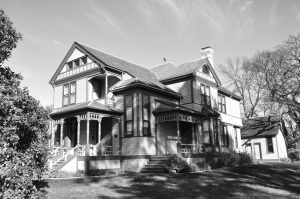
Creaky staircases, heavy wooden doors, and elaborate details in a Victorian house seem like the perfect setting for a scary movie. But at the historic Comstock House on 8th street in Moorhead, the house is brought to life with events highlighting history.
According to the Minnesota Historical Society website, the Comstock House was built in 1883 by Solomon G. Comstock. He was a local businessman and lawyer, and helped bring the railroad and other business to Moorhead. Originally built on the highest point in Moorhead, the house features oak doors and windows, stained glass, and intricate detail throughout the structure, down to the hinges on the doors. Today, the interior looks much the same as it did in 1883, thanks to restoration efforts by a group of local advocates for the house.
Through collaborations with faculty at Concordia College and other members of the community, the Historical and Cultural Society of Clay County works to make sure that history is a community affair. Events such as concerts, student performances, pumpkin carving, calligraphy demonstrations, and special exhibits at the Comstock House bring the community together to engage with each other and the past.
Matt Eidem, a 2007 Concordia graduate and Director of Museum Operations at the Hjemkomst Center, also manages the Comstock House. His job entails everything from programming and tours to maintaining the boiler and mowing the lawn. According to Eidem, events held at the Comstock House and the Hjemkomst Center offer an opportunity for everyone in the community to get involved with local history.
“The best way to understand local history is to attend events and to learn about it,” he said. “With Concordia, we have music events. We have lectures every month that are free for students to attend. It’s more experiential learning, so we have to try and get people to come out.”
Advertising through events on Facebook and posters on nearby college campuses draw interest from local students in particular. Minnesota State University-Moorhead junior Nick Dressler enjoys attending these events to spend time with friends and be involved with the community.
“[These events] are important because they get people out of their comfort zones and provide an opportunity to meet new people and make new friends,” he said. “Also, I just like carving pumpkins.”
One of the events hosted at the Comstock House in the fall is a community pumpkin carving, taking place on Saturday, Oct. 21 this year. The event is free and open to the public. Attendees receive a pumpkin to carve as well as free tours of the house, festively decorated for the season.
In addition to interactive events, performances are also held at the house. Earlier this fall, in collaboration with Concordia music faculty, Richard Wagner’s “Siegfried Idyll” was performed. Wagner wrote the piece for his wife as a gift in 1870 and hired musicians to line the stairs of the house and perform the piece as his wife woke up on Christmas morning. In a reenactment, Concordia musicians lined the staircase at the Comstock House and performed the piece for an audience.
One of those performers was Debora Harris, associate professor of flute at Concordia. She has participated in a few community events like this in the past, and plans to do more in the future.
“It’s fun to meld these two things together,” Harris said. “Art is art, whether it’s visual, or oral, or dance, and I think it’s really cool when those forces can come together. The whole idea of this project is so collaborative, so I want to just keep going on that idea and discover what kind of connections we can make.”
An expressive person, she finds unique ways to reach an audience through music and other art forms.
“Music and art have a way of touching us in a way that words can’t. Music and visual arts touch people in ways that you can’t hardly talk about,” she said.
Such events have a way of bringing the community together, and Eidem stresses the importance of attending them.
“I like to think that learning’s fun, and the events are fun. It’s a lot of fun to have a say in what happens in your town,” he said.
But perhaps the most important part, according to Eidem, are the lessons that can be learned from taking a step back and looking at history.
“You don’t know where you are unless you know where you’ve been,” he said. “By understanding our history, we know a lot more about things today.”

